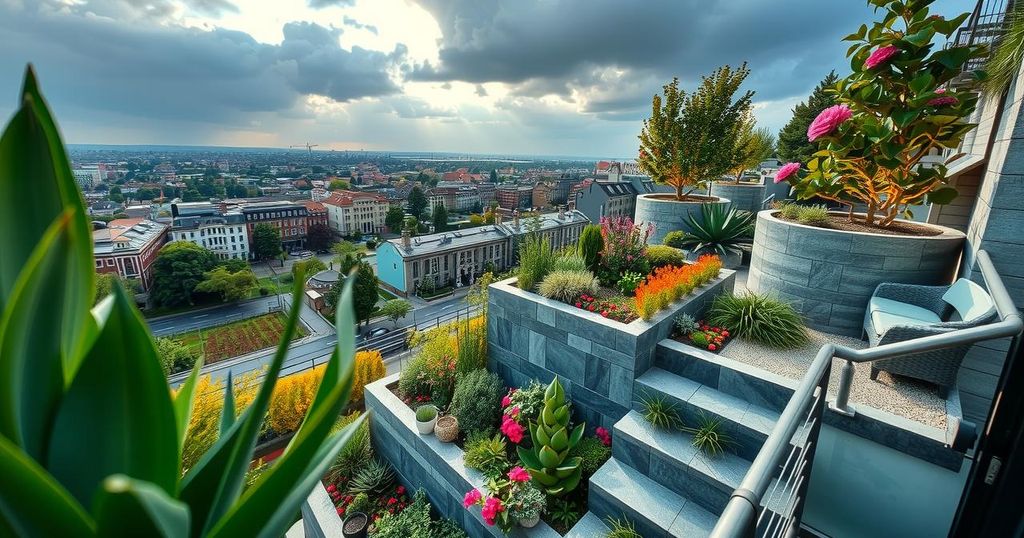The article highlights the urgent need for climate resilience in Indian cities due to extreme weather events, advocating for terrace and balcony gardens as a viable adaptive strategy. These green spaces not only help in temperature regulation but also support biodiversity and community engagement. Through supportive policies and incentives, these gardens could transform urban landscapes into healthier, more sustainable environments capable of coping with climate extremes.
The demand for urban resilience in India has intensified due to dire climatic events, as reported by the Centre for Science and Environment in their Climate India 2024 report. In the first nine months of the year, the country faced extreme weather nearly every day, resulting in over 3,000 fatalities and devastating 3.2 million hectares of agricultural land. These challenges are widespread across states and Union territories, highlighting the urgency for actionable and adaptable strategies to mitigate their effects.
Urban populations, particularly those employed in outdoor sectors or residing in temporary accommodations, confront heightened risks associated with escalating temperatures. As cities grapple with the strain of rising heat, existing infrastructures and public health systems are reaching their limits. Although governments are introducing night shelters, altering school hours, and conducting awareness initiatives, these measures prove inadequate in addressing the increasingly severe climate challenges.
In response, urban areas are progressively adopting green infrastructure solutions—including terrace and balcony gardens—as vital components for climate adaptation. Research indicates that integrating vegetation into urban environments can effectively regulate temperatures, thereby enhancing resilience against climate variations. Cities worldwide are reaping the benefits of such initiatives, with Copenhagen setting an exemplary standard by promoting green roofs and encouraging public engagement in gardening efforts.
Terrace and balcony gardens can play a pivotal role in ameliorating the adverse impacts of climate extremes, particularly during intense heat waves. Vegetation on rooftops and balconies provides natural shading and evaporative cooling, which can lower surface temperatures significantly. For instance, studies demonstrate that green roofs can decrease temperatures by up to 20°C compared to conventional concrete structures, yielding multiple advantages such as improved air quality and reduced energy demands for cooling.
Additionally, urban gardens permit residents to cultivate fresh produce, countering the urban heat island phenomenon while fostering a connection with nature that contributes positively to mental health. Beyond mitigating heat, these green spaces offer insulation during colder months, stabilizing indoor climates and reducing heating requirements. Moreover, green roofs serve as windbreaks, creating comfortable environments throughout the year.
The establishment of terrace and balcony gardens also promotes biodiversity by attracting various species such as birds, pollinators, and beneficial insects, thereby enhancing urban ecological stability and enriching city life. These gardens encourage community collaborations, creating platforms for sharing gardening knowledge and resources, thus strengthening neighborhood ties centered around sustainability.
For Indian cities to ascend as frontrunners in climate adaptation through green infrastructure, robust policy frameworks and incentives are essential. Modifying building regulations to facilitate green rooftop installations in new developments and providing financial benefits for homeowners retrofitting balconies with plants can foster widespread acceptance of these initiatives.
With adequate support and guidance, terrace and balcony gardens could become commonplace in Indian urban settings, offering a low-cost yet impactful approach to the pressing challenges posed by climate change. Such green spaces not only provide aesthetic advantages but are crucial for fortifying urban resilience against climatic adversities. By incorporating greenery into urban planning, Indian cities have the potential to transform into cooler, healthier environments that are better equipped to handle the complexities of climate uncertainty.
The article discusses the pressing need for climate resilience in Indian urban spaces, citing a report from the Centre for Science and Environment which outlines the severe impacts of climate change experienced in recent months. With rising temperatures and increased urban heat threats, particularly for vulnerable populations, the integration of green spaces such as terrace and balcony gardens emerges as a necessary adaptive strategy. These gardens can naturally regulate temperatures, improve air quality, and foster community engagement, presenting a pathway towards sustainable urban living.
In conclusion, the integration of terrace and balcony gardens represents a significant opportunity for Indian cities to enhance their resilience against the impacts of climate change. By adopting supportive policies and embracing green infrastructure, urban environments can mitigate extreme temperatures, improve air quality, and enrich community interactions. As cities face ongoing climatic challenges, the commitment to creating greener spaces could significantly contribute to healthier populations and more sustainable urban ecosystems.
Original Source: www.downtoearth.org.in






